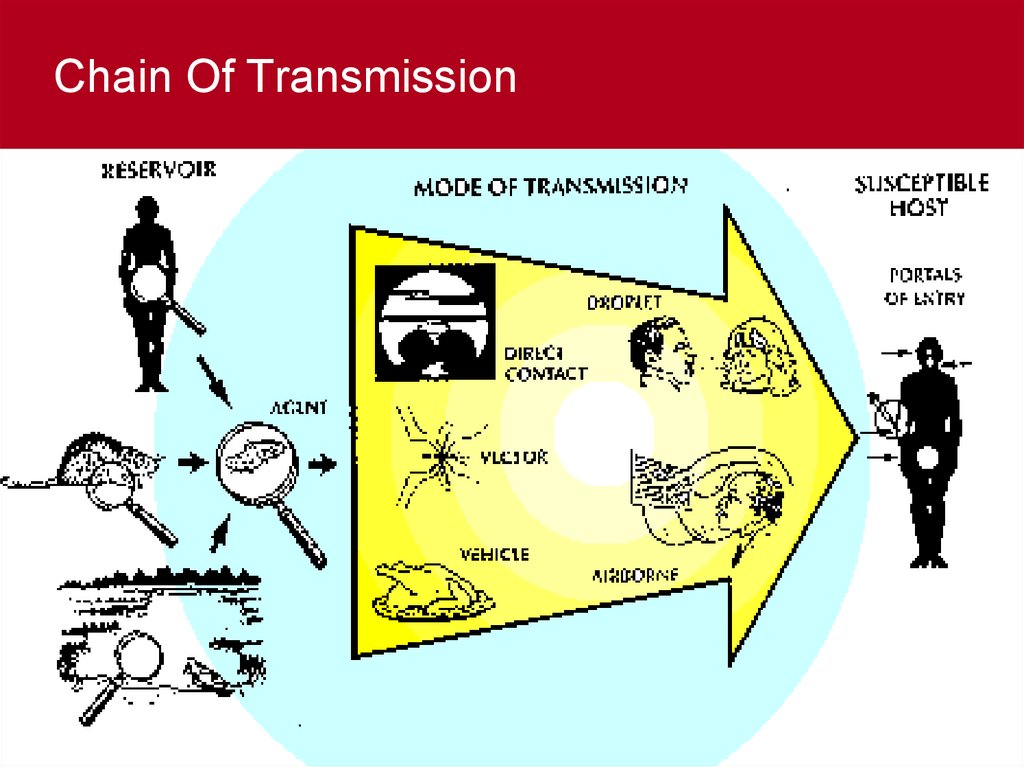Similar presentations:
Basic concepts in epidemiology
1. BASIC CONCEPTS IN EPIDEMIOLOGY
Dr.Moneer Ali AbdallahMBBS, MPH, PDHM,DRME, MD
2. OUTLINE OF THE LECTURE
Models of disease causationEpidemiologic triad concept
The natural history of disease
Chain of transmission
The iceberg phenomena
Herd immunity
3.
Whatis the disease ?
4. What is the definition of the disease ?
A satisfactory definition of disease is yet to be foundDictionary defines disease as:
a condition in which health is impaired or
a departure from a state of health….
Definition of the health:
Is state of well being in which all the components
of health are in balance
5. Concept of disease causation
Supernatural theory of diseaseGerm theory of disease
Ecological theory
Multifactorial causation
6. Supernatural theory :
In the early past, the diseasewas thought mainly due to either
the curse of god or due to the
evil force of the demons
7. Germ theory
Germ theory: Microbes (germs)were found to be the cause for
many known diseases.
8. Ecological theory
Around 463 BC, Hippocrates isthe first epidemiologist who
advised to search the
environment for the cause of the
disease
9. Multifactorial theory
PettenkofferStated that agent, host and environmental
factors will act and interact
synergistically causing the disease
10. EPIDEMIOLOGICAL TRIANGLE
Changes in one of theelements of the triangle
can influence the
occurrence of disease
11. Epidemiologic Triad Concepts
EpidemiologicEpidemiological
triad Triad Concepts
The traditional model of disease causation
3 components
an external agent
a susceptible host
an environment
12. Epidemiological triad
EpidemiologicaltriadTriad - Agent
Epidemiologic
Agent
Entity necessary to cause disease in a susceptible
host
Examples
Biological (bacteria, virus, parasites, etc)
Physical (radiation, physical force)
Chemical (pollutants, drugs, etc)
Nutrients (nutritional deficiency)
13. Epidemiologic Triad - Agent
Infectivity – ability to invade a hostPathogenicity – ability to cause disease
Virulence – ability to cause severe disease or
death
14. Epidemiologic Triad Concepts
EpidemiologicTriad
- Host
Infectivity, Pathogenicity , Virulence
all are dependent upon the condition of the host
immunity (active, passive)
nutrition
adequate rest & sleep
good hygienic practices
15. Epidemiological triad
EpidemiologicaltriadTriad - Host
Epidemiologic
Definition: person/organism that is susceptible to effect of
agent
Characteristics
Genetic
specific immunity
socio-demographic
age
sex
ethnicity
occupation
social class
16. environment
Epidemiologic Triad - EnvironmentDefinition : Conditions that influence interaction
between agent & host
Examples
Biological
physical (+ climate) & physical surroundings
social (+ socioeconomic conditions)
17. ENVIRONMENT
Epidemiologic Triad - EnvironmentEnvironmental conditions major influence on
health status of individuals in the population
War
Poor housing &
Poor Sanitation
Poverty
Floods
Earthquakes
Cyclones
Adverse climate
Pathogen’s ability to
survive
outside host?
affects
Transmission from
Host to Host
18. The Natural History of Disease
Historyof Disease
TheNatural
Natural
History
of Disease
The progress or course of disease in an
individual over time without any external
inversion .
It has 3 stages :
18
19.
Natural History of DiseaseDeath
Good health
Subclinical
changes
Clinical
disease
Recovery
•Cholera
•Dengue fever
19
20. The Natural History of Disease
Historyof Disease
TheNatural
Natural
History
of Disease
1.
Stage of susceptibility (before onset of disease)
age, sex, occupation, family history,Weight (obesity), smoking
2. Stage of exposure to the agent
3. Stage of subclinical disease
etiologic agent present in the body but has not caused any visible
symptoms or signs of disease.
4. Stage of clinical
5. Recovery or death
20
21. Incubation Period
IncubationPeriod
Interval between time of contact and/or entry of
agent and onset of illness
Time required for microorganism to multiply
within the host up to a threshold where the
microorganism population is large enough to
produce symptoms and/or signs of disease
21
22. Dynamics of Disease Transmission
TransmissibleInfectious diseases
Genetic diseases
Non-Transmissible
Many chronic diseases, eg :
diabetes and cancer,
23. Mode of Transmission
Definition: mechanism through whichinfective agent move from reservoir to
susceptible host
Direct
Indirect
24. RESERVOIRS OF INFECTION
Definition:habitats where infective agent can survive & (multiply).
Animals : zoonoses (animal human)
Environment : plants, soil, water
Human : case (person having disease)
25. Chain Of Transmission
26. Mode of Transmission
I.Direct:
From person-to-person
- Sexual contact
- Transdermal
- vertical from the mother to the baby
27. Mode of Transmission
II. Indirect :contaminated vehicles such as food, water,
inert objects (dressings),
- Vector borne (biological, mechanical)
28. Transmission of Disease
FomitesInanimate Objects
• Tissues, towel, drinking glasses, needles
Droplet Transmission
Saliva and Mucus
Coughing, Sneezing, Laughter
Less than 1 Meter
29. Mode of Transmission
Person-to-person (respiratory, oral, genital, skin, body fluids)E.g. tuberculosis, SARS, HIV, measles
Vector (insects)
E.g. rabies, yellow fever, dengue, malaria
Common vehicle (food, water)
E.g. Salmonellosis, cholera
Fomites (contaminated objects)
E.g. nosocomial infection
Intra Venous (blood & blood products)
E.g. malaria, hepatitis B
Transplacental
E.g.rubella, HIV
30. Iceberg Phenomena
31. ICEBERG PHENOMENA
VARIATION OF SEVERITY OF A DISEASE PROBLEMVISIBLE
DEAD
SEVERE CASES
“TIP OF THE ICEBERG”
CASES (CLINICAL ILLNESS)
INVISIBLE CASES
(ASYMPTOMATIC INFECTION)
INVISIBLE
31
32. ICEBERG PHENOMENA
EXAMPLES:Hepatitis B carriers
Cholera carriers
HIV/AIDS
33. HERD IMMUNITY
Definition: immunity or resistance of a HERD (populationgroup or community) to a disease
Resistance
of a group to invasion & spread of an infective agent is based
upon the resistance to infection of a high proportion of individuals in a group
Public Health Implication:
Thus an entire population does not have to be immunized
to prevent the occurrence of an epidemic
Example:
Measles virus transmission would stop if 70% of the population is
immunized
34.
Source:Timmreck, 1998
35.
Source:Timmreck, 1998
36. HERD IMMUNITY
If the infectious agent cannot find a susceptible host to infect,then an epidemic would die out.
Once
a certain level of protection against a given
disease is achieved by a population (probably around
70% - 85%), even the unprotected members are
protected because the uninfected population is not
large enough to serve as a reservoir
37. Herd Immunity Threshold for Selected Vaccine-Preventable Diseases Modified from Am J Prev Med 2001;20(4S): 88-153
DISEASEHerd Immunity
Diphtheria (4 doses)
85%
Measles
83-94%
Mumps
75-86%
Whooping cough
92-94%
Polio
80-86%
Rubella
83-85%
Smallpox
80-85%
38. SUMMARY
3839. Quesetion
?????????????????????????????????????????????????????








































 medicine
medicine








